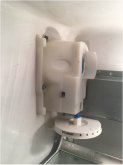Hedges
I See Electromagnetic Fields!
- Joined
- Mar 28, 2020
- Messages
- 20,600
My upright Frigidaire deep-freeze wasn't freezing anything more concentrated than ice cubes any more. Things were mushy and spoiling.
Maybe it just needs a refrigerant recharge; I'll look into that later.
Went to the store and found they all have 60 or 90 day delivery. Only come out of China, while refrigerator/freezers are often made in the States.
Read reviews and got scared by the 5% to 15% early failure rate of virtually all brands. Problem is probably electronics (my field.)
Old ones with electromechanical thermostats are reliable.
I finally picked up a new (old) refrigerator that is a good match to the kitchen decor. That set me back about 35 minutes wages.
With the old-old fridge now spare, a Magic Chef side by side given me by an acquaintance remodeling, I decided to convert it to all freezer.
It has been quite reliable and quite cold on the left side.
This is the one I reported power draw for: https://diysolarforum.com/threads/h...ries-die-in-four-hours.7753/page-3#post-89893

These have the thermostat in the refrigerator side, forced air cooling on the freezer side, and a passive baffle to spill some frozen air into the refrigerator.


If you open the baffle that just makes the freezer warmer when thermostat shuts off.
With baffle removed there is a 3" hole at the top. Bottom of fridge has a 1" hole to adjust vegetable drawer temperature.
After testing I'll decide whether to cut a 3" hole at bottom.
I substituted a $12 freezer thermostat:


It fits in the same place, but old adjustment wheel that was accessible through a cover isn't compatible, so leave cover off to access knob.
Modified and running now. I'll report back later how cold it gets. There's twice the surface area compared to freezer, and insulation might not be as thick but is probably the same all over. This unit has a bottom radiator with fan rather than one inside the walls, so an additional layer is a possibility.
Maybe it just needs a refrigerant recharge; I'll look into that later.
Went to the store and found they all have 60 or 90 day delivery. Only come out of China, while refrigerator/freezers are often made in the States.
Read reviews and got scared by the 5% to 15% early failure rate of virtually all brands. Problem is probably electronics (my field.)
Old ones with electromechanical thermostats are reliable.
I finally picked up a new (old) refrigerator that is a good match to the kitchen decor. That set me back about 35 minutes wages.
With the old-old fridge now spare, a Magic Chef side by side given me by an acquaintance remodeling, I decided to convert it to all freezer.
It has been quite reliable and quite cold on the left side.
This is the one I reported power draw for: https://diysolarforum.com/threads/h...ries-die-in-four-hours.7753/page-3#post-89893

These have the thermostat in the refrigerator side, forced air cooling on the freezer side, and a passive baffle to spill some frozen air into the refrigerator.


If you open the baffle that just makes the freezer warmer when thermostat shuts off.
With baffle removed there is a 3" hole at the top. Bottom of fridge has a 1" hole to adjust vegetable drawer temperature.
After testing I'll decide whether to cut a 3" hole at bottom.
I substituted a $12 freezer thermostat:


It fits in the same place, but old adjustment wheel that was accessible through a cover isn't compatible, so leave cover off to access knob.
Modified and running now. I'll report back later how cold it gets. There's twice the surface area compared to freezer, and insulation might not be as thick but is probably the same all over. This unit has a bottom radiator with fan rather than one inside the walls, so an additional layer is a possibility.



